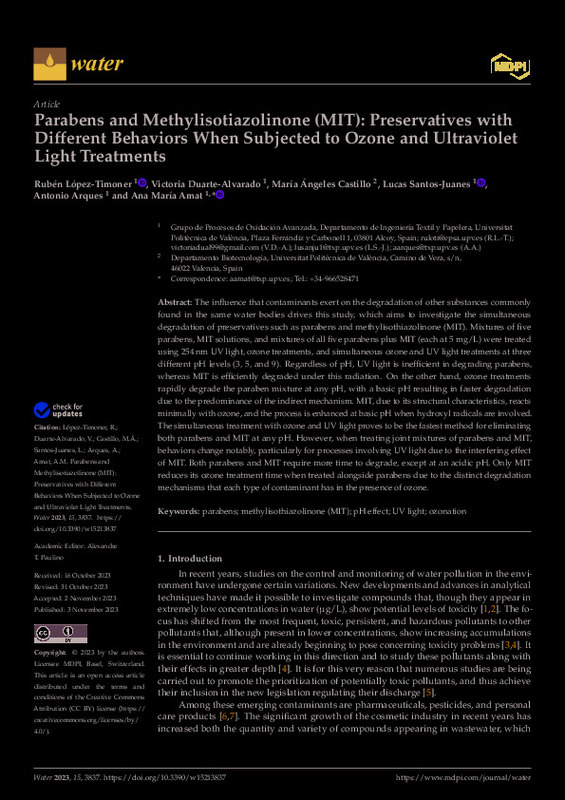JavaScript is disabled for your browser. Some features of this site may not work without it.
Buscar en RiuNet
Listar
Mi cuenta
Estadísticas
Ayuda RiuNet
Admin. UPV
Parabens and Methylisotiazolinone (MIT): Preservatives with Different Behaviors When Subjected to Ozone and Ultraviolet Light Treatments
Mostrar el registro sencillo del ítem
Ficheros en el ítem
| dc.contributor.author | López-Timoner, Rubén
|
es_ES |
| dc.contributor.author | Duarte-Alvarado, Victoria
|
es_ES |
| dc.contributor.author | Castillo, María Ángeles
|
es_ES |
| dc.contributor.author | Santos-Juanes Jordá, Lucas
|
es_ES |
| dc.contributor.author | Arqués Sanz, Antonio
|
es_ES |
| dc.contributor.author | Amat Payá, Ana María
|
es_ES |
| dc.date.accessioned | 2024-01-10T19:03:47Z | |
| dc.date.available | 2024-01-10T19:03:47Z | |
| dc.date.issued | 2023-11 | es_ES |
| dc.identifier.issn | 2073-4441 | es_ES |
| dc.identifier.uri | http://hdl.handle.net/10251/201747 | |
| dc.description.abstract | [EN] The influence that contaminants exert on the degradation of other substances commonly found in the same water bodies drives this study, which aims to investigate the simultaneous degradation of preservatives such as parabens and methylisothiazolinone (MIT). Mixtures of five parabens, MIT solutions, and mixtures of all five parabens plus MIT (each at 5 mg/L) were treated using 254 nm UV light, ozone treatments, and simultaneous ozone and UV light treatments at three different pH levels (3, 5, and 9). Regardless of pH, UV light is inefficient in degrading parabens, whereas MIT is efficiently degraded under this radiation. On the other hand, ozone treatments rapidly degrade the paraben mixture at any pH, with a basic pH resulting in faster degradation due to the predominance of the indirect mechanism. MIT, due to its structural characteristics, reacts minimally with ozone, and the process is enhanced at basic pH when hydroxyl radicals are involved. The simultaneous treatment with ozone and UV light proves to be the fastest method for eliminating both parabens and MIT at any pH. However, when treating joint mixtures of parabens and MIT, behaviors change notably, particularly for processes involving UV light due to the interfering effect of MIT. Both parabens and MIT require more time to degrade, except at an acidic pH. Only MIT reduces its ozone treatment time when treated alongside parabens due to the distinct degradation mechanisms that each type of contaminant has in the presence of ozone. | es_ES |
| dc.description.sponsorship | This research was funded by the Generalitat Valenciana (COSMETICFARMA Project, AICO/2021/014) and Spanish Ministerio de Ciencia e Innovacion (AQUAENAGRI) Project, PID2021-126400OB-C31). | es_ES |
| dc.language | Inglés | es_ES |
| dc.publisher | MDPI AG | es_ES |
| dc.relation.ispartof | Water | es_ES |
| dc.rights | Reconocimiento (by) | es_ES |
| dc.subject | Parabens | es_ES |
| dc.subject | Methylisothiazolinone (MIT) | es_ES |
| dc.subject | PH effect | es_ES |
| dc.subject | UV light | es_ES |
| dc.subject | Ozonation. | es_ES |
| dc.subject.classification | QUIMICA FISICA | es_ES |
| dc.title | Parabens and Methylisotiazolinone (MIT): Preservatives with Different Behaviors When Subjected to Ozone and Ultraviolet Light Treatments | es_ES |
| dc.type | Artículo | es_ES |
| dc.identifier.doi | 10.3390/w15213837 | es_ES |
| dc.relation.projectID | info:eu-repo/grantAgreement/GVA//AICO%2F2021%2F014//COSMETICFARMA Project/ | es_ES |
| dc.relation.projectID | info:eu-repo/grantAgreement/MICINN//PID2021-126400OB-C31//AQUAENAGRI Project/ | es_ES |
| dc.rights.accessRights | Abierto | es_ES |
| dc.contributor.affiliation | Universitat Politècnica de València. Escuela Politécnica Superior de Alcoy - Escola Politècnica Superior d'Alcoi | es_ES |
| dc.contributor.affiliation | Universitat Politècnica de València. Departamento de Ingeniería Textil y Papelera - Departament d'Enginyeria Tèxtil i Paperera | es_ES |
| dc.description.bibliographicCitation | López-Timoner, R.; Duarte-Alvarado, V.; Castillo, MÁ.; Santos-Juanes Jordá, L.; Arqués Sanz, A.; Amat Payá, AM. (2023). Parabens and Methylisotiazolinone (MIT): Preservatives with Different Behaviors When Subjected to Ozone and Ultraviolet Light Treatments. Water. 15(21):1-16. https://doi.org/10.3390/w15213837 | es_ES |
| dc.description.accrualMethod | S | es_ES |
| dc.relation.publisherversion | https://doi.org/10.3390/w15213837 | es_ES |
| dc.description.upvformatpinicio | 1 | es_ES |
| dc.description.upvformatpfin | 16 | es_ES |
| dc.type.version | info:eu-repo/semantics/publishedVersion | es_ES |
| dc.description.volume | 15 | es_ES |
| dc.description.issue | 21 | es_ES |
| dc.relation.pasarela | S\502949 | es_ES |
| dc.contributor.funder | Generalitat Valenciana | es_ES |
| dc.contributor.funder | Ministerio de Ciencia e Innovación | es_ES |








